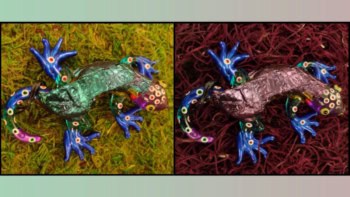
Arrays containing as many as 20,000 Josephson junctions have been created by physicists at CSIRO in Australia. The devices are made from a high-temperature superconductor and operate at liquid-nitrogen temperatures. With further development, the devices could be used in a range of applications, including magnetic-field sensing and as radio-frequency antennas.
The devices are called superconducting quantum interference filters (SQIFs), which are 2D arrays of superconducting interference devices (SQUIDs). A SQUID is a loop of superconductor that is broken in two places by Josephson junctions – electrical insulators through which the superconducting current can tunnel.
An important feature of a SQIF is that it comprises loops of different sizes. When a single SQUID is subject to an applied magnetic field, it develops a voltage that is a periodic function of the field strength. The period of this oscillation is related to the area of the loop, which means that the sum of voltages from a large number of SQUIDs with different loop sizes is more or less constant at most applied magnetic-field strengths – but has a very sharp minimum at zero applied field. This makes a SQIF extremely sensitive to very weak magnetic fields, as well as to electromagnetic radiation at radio and microwave frequencies.
Stepped approach
The SQIFs made by Emma Mitchell, Cathy Foley and colleagues at CSIRO comprised 20,000 Josephson junctions with loop areas that have a random size distribution. The Josephson junctions were made by creating several “steps” on the surface of a magnesium-oxide (MgO) substrate. The surface was then coated with a 220 nm layer of the high-temperature superconductor YBCO topped with a 50 nm gold layer. Finally, a patterning and etching process was used to create the loops. The Josephson junctions occur at the step edges, where the crystal structure of the YBCO is interrupted, creating an insulating gap of just a few nanometres.
According to Mitchell, the main challenge in building the arrays is reducing the variability in the operating parameters of individual Josephson junctions. These inconsistencies arise from difficulties in fabricating the tiny insulating gaps, as well as uncertainties in estimating the electrical properties of the superconducting thin film. “Accurate modelling of even simple [high-temperature] superconducting circuits remains a serious limitation in the early stages of development in this field,” explains Mitchell.
Radio antenna
The researchers’ SQIF is able to detect magnetic fields of less than about 1 μT with a sensitivity of 1530 V/T. In comparison, a similar array of identically sized loops has a sensitivity of just 165 V/T. The team was also able to use the SQIF to detect electromagnetic radiation at several frequencies, including 30 MHz.
Potential applications for SQIFs include highly sensitive magnetometers for use in geophysical exploration. The devices could also be used as large-bit digital-to-analogue converters; low-noise amplifiers; and sub-wavelength radio-frequency antennas. Mitchell points out that SQIFs based on high-temperature superconductors can be cooled using compact cryocooler devices, which means that they could be mobile and deployed in the field. This is unlike previous SQIFs that were based on low-temperature superconductors and are much more difficult to cool.
The team is now trying to improve the bandwidth and sensitivity of its devices by modifying the SQIF design and superconductor film parameters. “Future work will also focus on their operation in ‘real-world’ environments,” says Mitchell. The team has already managed to create SQIFs with as many as 54,000 Josephson junctions.
The SQIFs are described in Superconductor Science and Technology.



